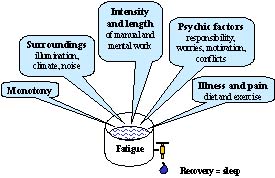
Vol. 15 No. 2, March 2004
Andrew Nicholls
The University of Melbourne
Australia
Leon Bren
The University of Melbourne
Australia
Neil Humphreys
Australian National University
Canberra Australia
The authors are, respectively, Researcher and Professor at the University of Melbourne and Professional Visiting Fellow at the Australian National University in Canberra.
ABSTRACT
Falling financial margins have prompted many owners of Australian harvesting businesses to extend normal working hours. After brief trial periods, most companies have again reverted to short-term and ad hoc solutions to meet peaks in demand.
The harvesting industry is also being persuaded to operate extended hours under the guise of service-delivery and the `24-hour society', in response to customer demand. A poor understanding of human factors poses a threat to profitable harvesting, and contributes to low productivity on extended hours work regimes.
Decreased operator productivity was observed in both shifts of a shiftwork operation. Experience in other industries have noted reduced operator alertness led to increases in the risk and severity of accidents and machine damage.
Successful implementation of extended hours work regimes relies on addressing operational needs as well as recognising the human needs, managing productivity, safety, communications and maintenance.
Keywords: harvester operator fatigue, productivity, Pinus radiata, alertness, sleep, light, Australia.
INTRODUCTION
Extended-hours refers to long working days, shift-work, and long periods of consecutive work days without time off. This study focused on long shifts and shift work. The paper also reveals some findings about operator productivity and mechanised timber harvesting in radiata pine (Pinus radiata) in Australia.
Plantation harvesting in south-east Australia is a year-round operation. A subtle peak in production occurs in summer when both longer daylight and drier operating conditions provide favourable site conditions.
Whilst out-of-hours work arrangements can reduce shift length, working at night is contrary to the circadian control that programs human behaviour, including sleep patterns. Furthermore, recent emphasis on shift-based harvesting has combined problems of circadian tiredness, weariness due to long working shifts, and the reductions in alertness associated with the monotony of the task. This not only results in negative impacts on profitability, but presents safety concerns as well.
The human body's circadian response programs us to sleep at night. Regular shiftwork cycles may help to override this tendency, though much research shows that shift workers acquire less sleep, and that sleep is of a poorer quality [2, 7].
Rest breaks of 10-minutes taken every 90 minutes, with the operator getting out of the cabin and stretching contribute to alleviating the task's monotony [13]. Kirk suggests long breaks of 30-40 minutes should be taken every 4 hours, interspersed with these shorter breaks.
Over the past decade, financial factors have pressured harvesting business owners to restructure and contain costs. The entry of major global businesses into the ownership of Australian forests and processing facilities has had substantial impacts on business processes. The low trading value of the Australian dollar has also made machinery costly. Thirdly, advances in automation, ergonomics, productivity, and environmental performance have kept demand buoyant for new harvesters. Over this time the allowances for equipment development once paid as loyalty rewards by the processors, have been phased out.
This study is the first of its kind in Australia to investigate the anthropocentric factors governing output from forest-harvesting machines. The project was designed as a broad-ranging sensitivity analysis to investigate areas where further research efforts should be placed. This paper highlights the major research areas covered.
The objective of the study was to investigate the effects extended hours of work had on the productivity of both the operator and the operation. Improving the understanding of the role human factors play in determining productivity will lead to business being more profitable, and also improve operator safety. This was achieved in part by comparing the experience from other industries.
MATERIAL AND METHODS
Fieldwork was undertaken in three major centres of radiata pine managed for timber and fibre production. This forest type now produces for Australia 15 million cubic metres of wood annually and covers 979,633 hectares [4].
Field data was collected from three large, long-term harvesting businesses. Operators had the choice to becoming involved or abstaining. Normal operating conditions prevailed, and the autumn/winter of 2002 provided favourable site conditions. Due to the number of operational variables unable to be controlled, research by case study was selected over more traditional randomised block designs. Nonetheless, the research was constrained by the operational considerations of large businesses, high-cost machinery and contract obligations.
All the workers studied operated larger, computerised harvesting machinery capable of recording hourly productivity in terms of the number of logs, the number of trees and the volume. This limited the number of operators and machines available to study.
First thinning (T1) operations were selected due to the higher monotony factor contributing to operator fatigue. Machine types tested included both wheeled and tracked single grip processors (Timberjack 1270, Valmet 911 and 921, and Timbco 425 and 445), and 6-wheeled forwarders (Valmet 890). Five experiments were undertaken as follows:
Working hours, alertness and fatigue were assessed using an alertness assessment with the visual psychomotor vigilance task (PVT) test of human reaction time (RT). Dayshift operators conducted tests on a hand-held PVT unit programmed for 6-minute tests taken at two hourly intervals [3, 8] for up to three days. Five operators completed 46 tests with an average of 51 responses per test.
Working hours were recorded in a work-log over a 3 week period.
The working light produced by the machine was measured using an illuminance meter. Open field recordings of the light produced by each machine was compared to that of the light in the outrow situation. The forest was 17 year old radiata pine thinned to 350 stems per hectare from an initial spacing of 2.4 x 3.1 m. The thinning system was 5th row out, with a diameter-based bay-thinning from below. Conclusions were drawn about the amount of light, and its intensity in relation to the task.
Light level was assessed on a 40 x 40 m measurement grid of decreasing intensity away from the machine. An in-forest assessment of light was also made at 4.0 and 6.0 m above ground level.
Air quality and cabin environment were assessed in the machine cabin using a data logger. CO and CO2 concentrations, and RH and temperature observations were recorded at two-minute intervals throughout the day in each of the five machines.
Sleep quality and duration were recorded using a sleep diary. This recorded the time to going to sleep, awakening time, and subjective scores of sleepiness at bed and waking time. Five operators recorded this data over a 21-day period.
A questionnaire on working hours and motivation was provided to employees of 8 large harvesting businesses (each more than 40 employees). The questionnaire results were compared with the sleep diary data.
An assessment of productivity was made involving two companies, one working only day shift, the other working a 2-shift operation spanning 21 operating hours per day. Data was collected hourly, along with a quick self-assessment made of psychological and other influences (e.g. environment, sleepiness, and stressors). The information recorded was the number of logs, the number of trees and volume harvested per hour using the machine's harvest control module. Productivities were calculated hourly, exclusive of time involved in breakdowns and delays. Analysis involved graphical and statistical techniques.
An estimate of mental workload was made by estimating the number of machine operating thoughts operators made in regard to machine movement and simple log processing decisions.
RESULTS
Dawson and Fletcher [6] comment that experimental studies typically over-simplify the complex psycho-social context in which shift work occurs. A model is proposed that assigns a fatigue rating given the number of hours spent at work.
Tasks of high cognitive demand also show they are more affected by operator fatigue than simpler tasks [6]. Increasing task complexity and increases in the number of decisions an operator makes, leads to operator performance becoming more affected by fatigue.
In a paper on fatigue-related road crashes in Australia, Haworth [12] groups fatigue inputs into five categories with a one-way recovery. The diagram is applicable to operators of harvesting machines (refer Figure 1).
Figure 1. Fatigue inputs and recovery. Adapted from Haworth [12].

Table 1 shows the average working hours for 10 operators studied (excluding travel time). Whilst averages differ, modes for both work regimes are similar.
Travel time varied between operators. One group travelled to the depot to begin work (9 mins), while operators starting in the bush averaged 46 min travelling time one way.
Table 1. Average operating hours per day.
| Shift (hr:min) | Average (hr:min) | Mode (hr:min) | Min (hr:min) | Max (hr:min) |
| Day - only | 9:45 | 10:08 | 4:35 | 13:13 |
| Morning | 10:39 | 10:30 | 10:00 | 12:00 |
| Afternoon | 10:23 | 10:30 | 9:59 | 11:00 |
Sleep
Krueger [14] recognises the importance of sleep to restore alertness and recharge motivation in sustained military performance.
Table 2 presents three recommended sleep minima. Operators found the 7-day sleep recommendation difficult to achieve.
Table 2. Minimum recommended sleep as suggested by Ferrara and De Gennaro [10] and Dawson [5].
| Period | Minimum sleep for period | Daily sleep | % sleep in period |
| 1 day | 5 hrs | 5:00 | 21 |
| 2 days | 12 hrs | 6:00 | 25 |
| 7 days | 50 hrs | 7:09 | 30 |
From the questionnaire, the average sleep gained by operators was 6:57 hrs per night. This is consistent with the 7-day sleep average from Table 3. While all operators met the minimum sleep over one day, no operator averaged seven hours sleep per night during the working week. Only one operator achieved the 7-day sleep recommendation. Another operator averaged 5% less sleep per working-night than the recommended for a 2-day period.
The weekly sleep totals of individual operators varied by less than two hours in a week. This was the case even though the length of the nightly sleep was highly variable.
Table 3. Average weekly hours of sleep.
| 7 day average | Work day sleep (hrs) | Rest day sleep (hrs) | Difference |
| 6:51 | 6:16 | 8:41 | 39% |
Comparing working-week and weekend sleep averages revealed that operators had distinctly bimodal sleep habits. On average, the length of sleep on rest days exceeded sleep on work days by 39% (range 15 to 94%). Four out of five operators had sleep patterns that generated in excess of 25% more sleep on rest-days. One operator averaged 94% more sleep on rest days than during the working week. Figure 2 shows the nightly sleep averages from the start of a new roster period for n=96 observations. The shortest sleep and the least variability in sleep length coincided with the sleep after the third rostered shift. This implies that operator fatigue will be highest towards the end of the working week.
Working hours, alertness and fatigue
Kirk [13] showed that the subjective mood of operators tended to become more sleepy and weary as the day and the shift progressed. With a higher frequency and duration of rest breaks, Kirk argues that the magnitude of the increase of sleepiness or weariness was less when time for recuperation increased [13].
Operator reaction time averaged 191 milliseconds. This was 17% faster than the average expected for a population of 20-40 year old males (230 ms) [19]. Response time slowed and became less predictable in the mid morning coinciding with circadian tiredness (see Figure 2).
The slowest 10% of reaction time responses highlights the risk associated with reduced alertness, and the effect of long periods of time-on-task. Figure 3 shows cognitive delays and lapses in attention as longer response times (increases in reaction time). Figure 3 also shows that variability in reaction time was greatest at the same time as the slowest response times were recorded (0831 - 1030 h). Workers rising early have an expected circadian dip in the mid morning. This dip coincided with the slowest reactions times and the highest standard error. Such impacts on alertness have ramifications for safety.
Figure 2. Average length of sleep per night from the start of the new roster period (dayshift).
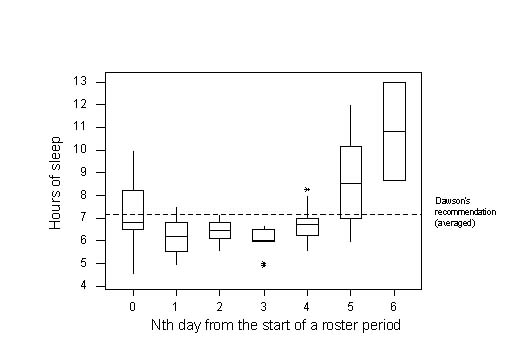
Figure 3. Slowest 10% of reaction times for day-shift operators
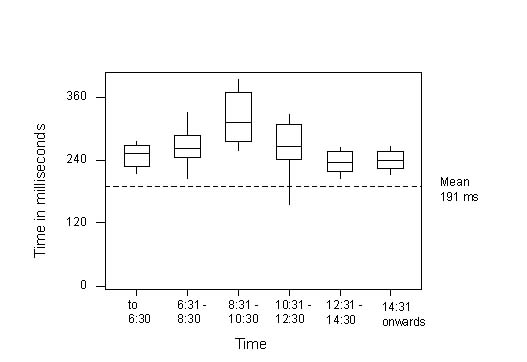
Increases in reaction time with time-on-task were expected but not observed. These operators were highly practiced at responding to visual stimuli with their hands. Secondly, the data were collected over a short period of time, and the operators viewed this short-term task as a personal challenge and were motivated to improve their performance.
As a measure of operator alertness, reaction time was shown to be poorest around the circadian trough of mid morning. Dayshift workers recorded the slowest reaction times in mid morning, consistent with accident statistics. Skipping breakfast and poor dietary practices have implications in terms of blood sugar level, these being likely to contribute to operator tiredness [1, 2].
Ambient lighting
In the order of 600 Lux is required for detailed work [9, 18] (e.g. product making decisions based on tree-form and log-quality).
Due to the predominantly dark colours, the Australian forest absorbs light. This contrasts significantly with the reflected light of a snow-covered forest floor in harvesting operations in Scandinavia.
Working lights commonly consisted of 70 W quartz halogen globes with diffusing lenses (see Table 4). The Timbco lighting produced very concentrated light using two pencil-beam spotlights; machines where the cabin indexes with the boom required less light.
A 10 year old forwarder produced a maximum of 150 Lux of light 5.0 metres from the cabin. Processors provided from 350 to 900 lux of usable light at the harvesting head. However, the distribution pattern and the resulting glare also varied considerably between machines. Oil-smeared or dirty glass further reduced the amount of light reaching the operator's eyes.
The combination of dim lighting, high absorbance and poor maintenance of lamps reduced available light. Low light reduced visibility for night work and affected log making and sorting decisions. Figure 4 compares the open-air distribution of light from a 10 year old forwarder, to that of the in-forest setting of a first thinning outrow. Isolux contours in Figure 4 (b) show the reduced illumination to the left side of the forwarder due to retained trees blocking light. As well as dim light, operators found shadowing and glare inhibited visibility and precision of machine positioning, thereby reducing productivity. Operators working in poor light lacked confidence and became unwilling to attempt difficult terrain at night.
Generally, sufficient light was provided near the harvesting head for tree felling and log processing functions. Light levels around the machine were poor for navigation. Tree selection based on upper tree attributes was not possible at night because less than 10 Lux were recorded 6.0 metres above the ground and the operators could see very little at heights greater than 4.0 m above ground level.

Display large image of Figure 4
Figure 4. Isolux curves of (a) open-air and (b) within thinned forest, 17 year old, T1, 350 sph. (Operator is situated at the origin facing the direction of the arrow).
Table 4. Light output by machine.
| Machine | Number lights | Tested wattage | Maximum recorded lux |
| Valmet 890 | 16 | 1,005 | 216 |
| Valmet 921 | 23 | 1,480 | 600 |
| Timbco 425 | 9 | 420 | 900 |
| T/jack 1270 | 20 | 1,230 | 230 |
The amount, distribution and the colour rendering properties of broad daylight (upwards of 22 000 Lux) provides many intangible benefits for forest harvesting operations. While higher power means more light for similar bulb types, luminaries like the high-intensity discharge (HID) lamps produce four times the light of similar power-rated halogen globes. Typically, a set of 20, 70-Watt lights on a 24 Volt system draws 58 Amps. By adapting alternative lighting systems to machines regularly operating at night, will reduce power consumption and improve the luminous efficiency.
Air quality and cabin environment
Atmospheric CO2 levels are currently at 365 ppm. Ventilation guidelines typically use 1,000 ppm as the maximum level for prolonged exposure. A limit of 5,000 ppm is the industrial safe work threshold where complaints of `stuffy' air, shortness of breath, feeling hot, headaches and fatigue become common [18].
Cabin temperature and CO2 readings exceeded recommended levels in 2 out of 5 machines sampled. In three out of five machines, CO2 levels were above 2,000 ppm for more than 50% of the operating time. Figure 5 shows an example of poor operating conditions where 5,800 ppm of CO2 was recorded on two occasions during the day. Changes in cabin relative humidity (RH) appear to provide a potential for a low-cost indicator of poor air exchange.
Figure 5. Cabin environment - high temperatures and high CO2 concentrations are indicated by increases in relative humidity. CO concentration remained at benign levels.
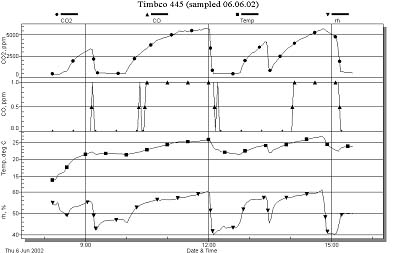
Winter cabin temperature exceeded 25oC in both the Timbco 445 and the Valmet 890. Temperatures above 25oC are unacceptable for long periods of work in an office and not conducive to alertness, particularly in combination with high RH and CO2 levels [18].
CO concentration within the cabin was likely to be a concern as a result of the orientation of air conditioning intakes and the slow dissipation of exhaust fumes in the forest. At no time did the cabin CO concentration rise above 2 ppm.
Productivity
Consistent hourly productivity was achieved where one operator was assigned to one machine, and worked only day-shift. In a 2-shift operation, it was shown that marginally more wood could be produced but this required significantly more time.
Table 5 shows far greater variability in productive performance was evident in operators working shiftwork. Supervisory and management factors may contribute to this as afternoon shift was often left without dedicated supervisors and the transfer of information at the shift changeover resulted in poor performance immediately after the shift-change.
In 2-shift operations, operator productivity was slow to reach optimum from the start of the shift. While this was understandable for dayshift operators commencing work at 0300 h under artificial lights, the afternoon shift commenced under ideal lighting conditions recorded longer times to reach optimum productivity levels. The CV in hourly productivity for day-only work averaged only 20%.
Table 5. Coefficient of variation in hourly productivity (%).
| Company 1 Shiftwork regime (T1) | Company 2, Diurnal work |
||
| Day shift | Night shift | ||
| 55 | 64 | ||
Afternoon shift averaged 78% of the day shift production. Figure 6 compares cumulative production for morning and afternoon shift operators from a shift-based operation.
Figure 6. Daily productivity averages for day and night shift.
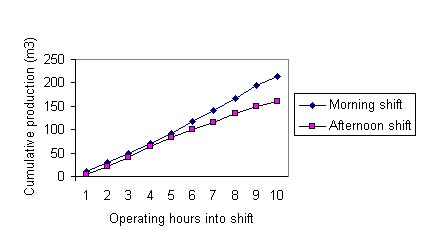
Figure 7 shows actual production from the shift work regime, and forecast production for the diurnal 1-shift regime (based on performance in a smaller stand). Over a 24-hour period, the 2-shift regime produced 22% more wood than the day-only operation, yet it took 62% more time to achieve this.
Figure 7. Productivity - observed shiftwork and forecast diurnal shift.
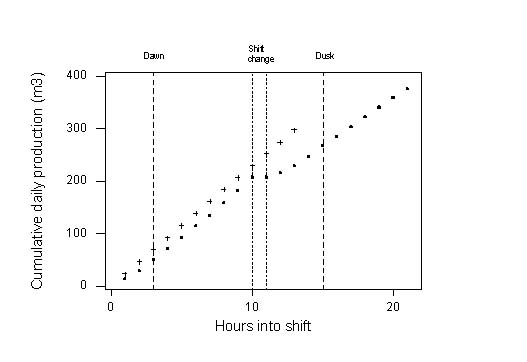
The mental workload of the operator was indicated by estimating the number of machine operating thoughts (MOT) for operators of processors. In T1 operations, this ranged from 30,371 for an afternoon shift operator on a delayed thinning, to over 120,130 for the operator of a high production machine in small piece size working dayshift. Aviation and road transport industries have been long interested in the effect on performance of increasing mental demand [15, 16]. Mental fatigue increases with the mental effort expended [16]. The effects on task performance from increasing cognitive demand from production, site, and environmental pressures is unknown [11, 17].
DISCUSSION
The timber harvesting industry in Australia faces challenges in reducing the length of time operators spend at work. While increasing the working hours of plant often reduces costs per unit of output, operators are likely to be less alert after long hours at work and when working at night. Successful operation of harvesting machinery requires good understanding of productivity, business economics, and human factors. Forest harvesting also comprises difficult terrain, isolated work, and environmental and productivity pressures, all of which contribute to operator fatigue. These vocational aspects, together with an understanding about extended working hours and its affect on operators, are an area of forest management requiring further investigation.
Maintenance of the ventilation systems would alleviate these concerns. Ambient temperatures peaked at 20oC, yet cabin temperatures rose to 28 oC as the heat build-up from hydraulics and the power plant rose. This was most noticeable in the excavator-base configurations. No machines were fitted with devices or systems for cabin climate control.
Poor air exchange exacerbates the effects of truncated sleep, unfavourable lighting conditions and personal characteristics like mood and health, exercise and fitness considerations. This is also a vehemently easy and low cost aspect to resolve.
The potential impact of high CO2 levels on the alertness of operators working long hours in cabins while performing highly repetitive tasks and experiencing low levels of physical activity, is high. Because operators can over-ride the air exchange system in modern harvesters, there is a strong case for cabin ventilation systems to incorporate automated fresh air exchange including temperature and humidity control. Other causes of poor air exchange rates include ducting and filtration blockages.
The study of workplace lighting for night operations demonstrated that while illumination of the harvesting head broadly met requirements, ambient illumination is poor. Light distribution is compromised by light absorption by the forest, and maintenance neglect of the lighting system. Poor illumination hampers perception of detail and reduces the precision of the work.
The distribution of light to alleviate glare, dark spots, and contrast brightness requires more research. In the interim, maintenance of existing lighting systems will overcome some of these shortcomings. Developments in lighting technology in other industries have applications in harvesting.
Operator fatigue is responsible for not only machine damage and safety concerns, but also stand damage, and preventing full forest value from being realised by careless processing and selection decisions.
While this study revealed that operators working long hours showed minimal reduction in alertness, information from other industries is to the contrary. Alertness was high where operator motivation was maintained, and fatigue onset appeared to be subverted. Evidence of motivation by financial incentive was present, yet family and recreation time were valued highly by greater than 95% of operators.
CONCLUSION
This study contributes to the understanding of the productivity of forest harvesting by highlighting that simple and apparently minor aspects of management and operating environment affect productivity in ways likely to be far greater than first thought. The study indicated that productivity improvements are likely to follow where sufficient planning and supervisory capacity is provided before extended-hours working arrangements are commenced. Productive, profitable and safe operation of forest harvesting machinery is reliant on motivated, mentally alert operators, working in well-organised businesses.
To remain competitive in the global timber industry, the Australian harvesting sector must continue to be profitable. Competitive and realistic harvesting rates must be paid based on realistic productivity expectations. Otherwise, the intellectual capital developed by the Australian harvesting industry will be thwarted. With improved knowledge of these issues, and strategies to manage and control their impact, extended hours harvesting will enjoy a future in Australia.
Many of the suggested improvements to extended hours operations could occur quickly and at low cost (e.g. improvements to operator morale and the management of machine maintenance).
Operating harvesting machinery in steep terrain at night in the limby Australian radiata pine forests is made complex due to poor visibility. In high growth-rate stands, it is not likely to be viable to operate harvesting machinery on a 2-shift basis. Conversely, regular and uniform plantations on near-level terrain provide good opportunity for trailing and developing productive night-time harvesting operations.
Further research to quantify human factors impacts on productivity is needed, particularly into light, shift work and value recovery.
AUTHOR CONTACT
Andrew Nicholls can be reached by email at -
AndrewN@sf.nsw.gov.au
REFERENCES
[1] Akerstedt, T. 1988. Sleepiness as a consequence of shift work. Sleep 11:17-34.
[2] Akerstedt, T. 1995. Work hours, sleepiness and the underlying mechanisms. Journal of Sleep Research 4:15-22.
[3] Ambulatory Monitoring Inc. 1996. PVT-192: user's guide and reference manual. Ardeley, New York. 52 pp.
[4] Bureau of Rural Sciences. 2000. National Forest Inventory 2000. Bureau of Rural Sciences, Canberra.
[5] Dawson, D. 2002. Pers. comm. in Adelaide, Australia on 20. May 2002.
[6] Dawson, D. and A. Fletcher, 2001. A quantitative model of work-related fatigue: background and definition. Ergonomics 44: 144-163.
[7] Dinges, D.F. and N.B. Kribbs. 1991. Chapter 4 - Performing while sleepy: Effects of experimentally-induced sleepiness. In: Monk, T.H. [Ed.] Sleep, Sleepiness, and Performance. Wiley, Chichester ; New York. pp. 97-128.
[8] Dinges, D.F., F. Pack, K.. Williams, K.A. Gillen, J.W. Powell, G.E. Ott, C. Aptowicz and A.I. Pack. 1997. Cumulative sleepiness, mood disturbance, and psychomotor vigilance performance decrements during a week of sleep restricted to 4-5 hours per night. Sleep 1997 20:267-277.
[9] Electro-optical Industries. 2002. The unit of luminous intensity: Candela (cd)., Electro-optical Industries. 4 pp.
[10] Ferrara, M. and L. De Gennaro. 2001. How much sleep do we need? Sleep Medicine Reviews 5. pp. 155-179.
[11] Gaillard, A.W.K. 1993. Comparing the concepts of mental load and stress. Ergonomics 36:991-1005.
[12] Haworth, N. 1998. Fatigue and fatigue research: the Australian experience. Accident Research Centre, Monash University.
[13] Kirk, P. 1998. The impact of shift length on processor operator fatigue. In: LIRO Report, Logging Industry Research Organisation, Rotorua, New Zealand. 10 pp.
[14] Krueger, G.P. 1991. Sustained, military performance in continuous operations: combat fatigue, rest and sleep needs., United States Army Aeromedical Research Laboratory. Fort Rucker, Alabama. 19 pp.
[15] Persson, A., B. Wanek, and A. Johansson. 2001. Passive versus active operator work in automated process control - a job design case study in a control centre. Applied Ergonomics 32:441-451.
[16] Sirevaag, E.J., A.F.Kramer, C.D. Wickens, M.Reisweber, D.L. Strayer and J.F. Grenell. 1993. Assessment of pilot performance and mental workload in rotary wing aircraft. Ergonomics 36:1121-1140.
[17] Sullman, M. and S. Gellerstedt. 1997. The mental workloads of mechanised harvesting. New Zealand Forestry. 48 pp.
[18] Weimer, J. 1993. Handbook of ergonomic and human factors tables. Prentice Hall, Englewood Cliffs, N.J.
[19] Woodson, W.E. and N.P. Chopey. 1987. Human factors reference guide for process plants. Engineering Reference Guide Series, McGraw-Hill, New York. 317 pp.